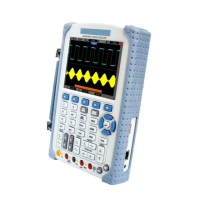Basic Operation
DSO1000B Series HandHeld Oscilloscope User Manual 33
As shown above, acquire input signals (cycle repeatable) for more than once at a slow sample rate,
arrange the sample points by the time they appear, then recover waveforms.
5.5.4 UTILITY
Push the UTILITY button to display the Utility Menu as follows.
System Info Display the software and hardware versions, serial number and some other
information about the oscilloscope.
Update
Program
Insert a USB disk with upgrade program and the disk icon at the top left corner is
highlighted. Press the Update Program button and the Software Upgrade dialog
pops up.
Save
Waveform
Insert a USB disk and the disk icon at the top left corner is highlighted. Click on
this icon and you can see the waveform pause for a while, being saved. You can
find the saved waveform data under the Hantek_x folder in the USB disk. Here X
represents how many times y
ou press the button. Each press generates a
corresponding folder. For example, press once and a folder Hantek_1 is
generated; press twice and two folders Hantek_1, Hantek_2 are generated.
Press this option and the Self Calibration dialog pops up. Press F6 to perform the
self calibration.
Advance Buzzer and time setups
See the dialog for buzzer and time setups
Self Calibration: The self calibration routine can optimize the precision of the oscilloscope to fit
the ambient temperature. To maximize the precision, you should perform the self calibration once
the ambient temperature changes by 5℃ or m ore. Follow the instructions on the screen.
Tip: Press any menu button on the front panel to remove the status display and enter a
corresponding menu.
5.5.5 CURSOR
The Cursor Menu.
Select a measurement cursor and display it.
Voltage measures amplitude while Time measures time and
frequency.
Select a waveform to take the cursor measurement.
Use the readouts to show the measurement.

